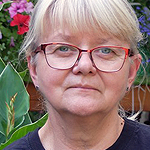Río Peyán, Guatemala, Jungle Area, Submerged Roots Habitat
6th place in Biotope Aquarium Design Contest 2019
United Kingdom. Lee Nuttall

Volume: 540 L
Dimensions: 150 x 60 x 60 cm
List of fishes: Thorichthys meeki, Poecilia mexicana, Xiphophorus hellerii
List of plants: NA
Description of decorations: Sand and gravel mix substrate. River boulders and small cobbles/pebbles, wood root, beech tree branches and windmill palm all collected locally.
Description of equipment: EHEIM classic 600 with both biological and mechanical filtration, 1 x Arcadia T8 38W freshwater lamp, EHEIM thermo control 250 heater
Water parameters: Temperature is 27°C, 80.6F, pH is 7.5, Ammonia is 0 ppm, Nitrite is 0 ppm, Nitrate is 20 ppm, GH is 18.
Additional info: Temperature is 27°C, 80.6F, pH is 7.5, Ammonia is 0 ppm, Nitrite is 0 ppm, Nitrate is 20 ppm, GH is 18.
INFORMATION ABOUT BIOTOPE
Description of the area surrounding the biotope: Lachuá is an oligotrophic and meromictic karstic lake in the region of Alta Verapaz and belongs to the southern upper reaches of the Usumacinta River drainage basin. The lake is located in the centre of the Laguna Lachuá National Park (LLNP, 15°53’ N, 90°40’W), south of El Petén and the south-eastern Mexico border. There are 5 affluents which flow into the main lake. My biotope is based around the River Peyán, which is positioned on the Western side of the basin. The Peyan River forms the main water inflow and the Lachua River its outflow. The area is lined with tropical rain forest. Riparian areas around the Río Peyán are composed of mainly trees, palms and submerged grasses.
Description of the underwater landscape of the biotope: The Río Peyán is one of 3 permanent affluent river mouths to the main Lake. Habitat is reported to be a mainly calcareous rocky bank where the mouth opens on to muddy shore. Canopies of shading trees contiguously go down into water surface, where there are lots of tree trucks, roots and general wood and leaf litter mainly composed of surrounding trees and palms. Substrate is reported to be sand and gravel, but mainly a dominant emphasis towards gravel and small rocks. A greater number of fish species is recorded around the River mouths and littoral zones.
Description of the parameters of the habitat: Water is reported to be very clear with a blueish tinge. Water velocity can be slow to moderate depending on the seasons. Increased velocity is reported during the wet season. Water parameters recorded are T=28.2oC, pH=8.0, C=960.5 μS, H=1081 mg/l, S=390 mg/l, NP=0.21 mg/l.
List of fishes and invertebrates occurring in the nature biotope: Cichlid species: Chuco intermedium , Cincelichthys pearsei , Cribroheros robertsoni, Maskaheros argenteus, Oscura heterospila, Parachromis multifasciatus, Petenia splendida, Rheoheros lentiginosus Thorichthys helleri, Thorichthys meeki, Thorichthys pasionis, Trichromis salvini, Vieja bifasciata, Vieja melanurus. Non cichlid species: Astyanax aeneus, Belonesox belizanus, Gambusia yucatana, Heterandria bimaculata, Hyphessobrycon compressus, Poecilia Mexicana, Xiphophorus hellerii.
List of plants found in the nature biotope: True aquatic plant life is devoid apart from submerged grasses and fallen palm leaves from the canopy above.
Threats to the ecology: –
Sources of information: Fishes from Lachuá Lake, Upper Usumacinta Basin, Guatemala, Pablo Granados-Dieseldorff 1,2*, Mäds F. Christensen 3 and P. Herman Kihn-Pineda 2012
Comments of the members of the jury of Biotope Aquarium Design Contest 2019

This tank excels in so many ways. Despite the initial impression of complexity, its strength actually resides in its simplicity: with just the congenial assembly of Molly, Swordtail and Firemouth, this is a tank that will forever be free of friction. Additionally, the absence of living greenery (supplanted by eye-catching palm fronds and alternative leaf litter options) means that there is nothing for the cichlids to uproot or the livebearers to strip in their gluttony. Although the tank runs the slightest risk of Firemouth aggression, the large volume and calculated hiding places make this a minimal concern.

Very nice setup, natural. Confratulation to author but, however, it is a pity that the author did not provide literature or other documentation used to prepare this aquarium. For me, such jobs should not be in the TOP 10.

Wonderful tank, the right species for the place species. The only thing that irritated me a little bit is the arrangement of the palm leaves in the background.

The materials are the correct ones for recreation. It is a very attractive arrangement, although I would like to recommend considering more the aspects of scattered detritus, since it is very rare to observe in the nature in these regions so pure (clean) background as well as other elements with a greater degree of degradation. In general the composition is very elegant. Congratulations!

This unique Guatemalan jungle river biotope plunges us into a sheltered alcove among rounded river rocks and sinuous tree roots. The bold outlines of these objects dominate the view, and together with a few strategically placed dead palm fronds, entirely obscure the boundaries of the tank. It is a boisterous and lively scene. In the open spaces between the tangles of broken twigs, exceptionally robust firemouth cichlids strut and square off in pairs to stake their territorial boundaries. The livebearers are a frenzy of activity, stirring up detritus as they search for food along the rocks and chase one another about. All the fish are thriving in this carefully crafted facsimile of their natural habitat.

One of my favorite fish combinations in this contest. A nice, big tank with a lot of hiding possibilities. Only minus for me is that I would like to see more of the blueish background. No it feels a bit nervous.

This work is not only a biotope aquarium, but also an excellent aquascape that I specialize in. The arrangement of large driftwood is perfect as a balance of composition, and giving the work a sense of strength and depth. The colors of the fish are excellent, and the pair laying eggs proves that the environment of this tank is optimal for them. It ’s a perfect work in every sense.
